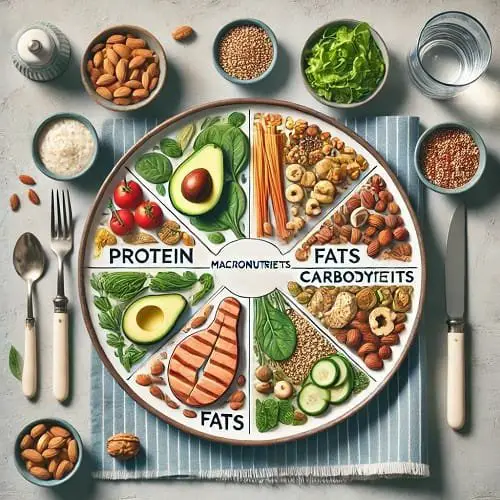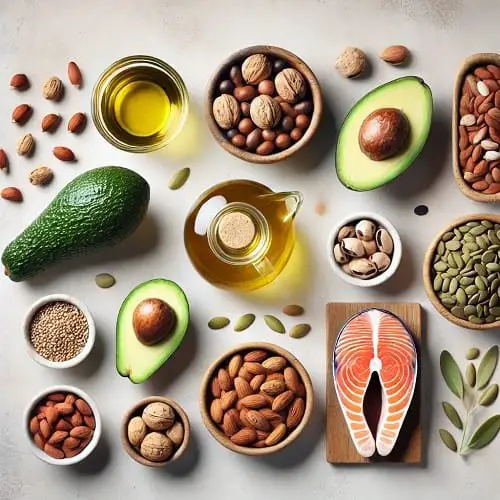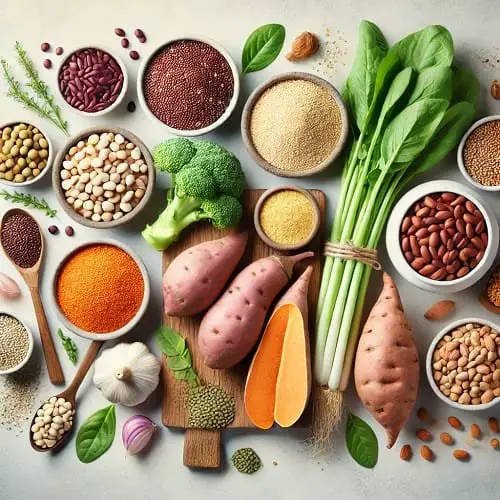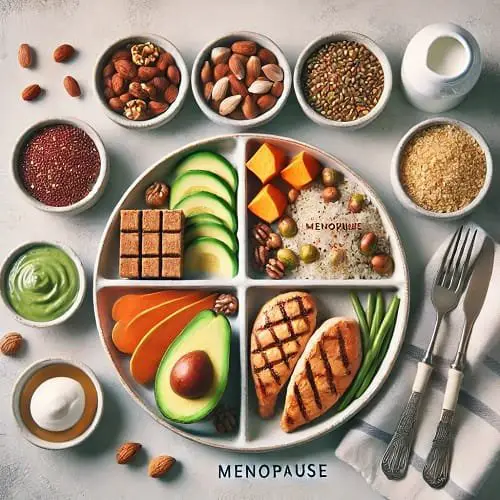1. Introduction
As women approach menopause, their bodies undergo a variety of changes that can lead to discomfort and health concerns. Menopause symptoms such as hot flashes, night sweats, mood swings, and weight gain are common, but they don’t have to define this phase of life. One of the most effective ways to manage these changes is through proper nutrition, specifically by understanding and balancing macros for menopause.
Macros for menopause refer to the three key macronutrients — protein, fats, and carbohydrates — that our bodies rely on for energy and health. When balanced correctly, these macronutrients can help alleviate many of the common menopause symptoms. Nutrition plays a crucial role in supporting the body during this time, and understanding how to incorporate the right healthy fats and protein for menopause is essential for maintaining well-being.
In this guide, we’ll explore why understanding and optimizing macros for menopause is vital for supporting the body’s needs. You’ll also find practical advice on how to use nutrition to reduce symptoms, enhance mood, and keep energy levels steady. By adjusting your diet to match the body’s changing needs, you can feel more in control of your menopausal experience.
Table of Contents
- 1. Introduction
- 2. What Are Macros and Why They Matter During Menopause?
- 3. How Protein Macros for Menopause Can Support Your Health
- 4. Fats: The Misunderstood Macronutrient for Menopause
- 5. Carbohydrates and Their Impact on Menopausal Symptoms
- 6. Balancing Macros for Menopause: A Holistic Approach
- 7. Additional Nutritional Tips for Managing Menopause
- 8. FAQs About Macros for Menopause
- 9. Conclusion
2. What Are Macros and Why They Matter During Menopause?

To fully understand how macros for menopause can support your health, it’s important to first know what macronutrients are. Macronutrients are the essential nutrients required by the body in significant quantities to supply energy and support vital functions. The three primary categories of macronutrients are proteins, carbohydrates, and fats. Each one plays a unique role in promoting health and well-being, especially during menopause.
- Protein is crucial for muscle repair, immune function, and hormone regulation. During menopause, women often experience muscle loss due to hormonal changes. Including sufficient protein in the diet helps to maintain muscle mass and manage menopausal weight loss.
- Carbohydrates provide the body with quick energy, but not all carbs are created equal. It’s important to choose essential nutrients for menopause like whole grains, vegetables, and fruits that offer fiber and steady energy without causing blood sugar spikes that could exacerbate symptoms like mood swings and fatigue.
- Fats are often misunderstood but are essential for hormone production, brain function, and cell health. Healthy fats, such as those found in avocados, nuts, and fish, support the body’s ability to balance hormones and maintain overall health during menopause. These fats also help to alleviate common symptoms such as dry skin and low energy.
Understanding how to balance these macronutrients is particularly important during menopause, as the body’s hormonal shifts can alter how it processes and utilizes these nutrients. With the right macros for menopause, you can help stabilize your energy, mood, and metabolism. In the next sections, we’ll dive deeper into the specific roles of protein for menopause, healthy fats, and carbs and how you can incorporate them into your daily routine for optimal health.
3. How Protein Macros for Menopause Can Support Your Health

As women transition through menopause, one of the most significant challenges they face is maintaining muscle health. Hormonal changes, particularly the decline in estrogen levels, can lead to the loss of lean muscle mass and an increase in body fat. This shift can be frustrating, especially when it comes to weight management. However, focusing on protein macros for menopause can be a game-changer in supporting overall health during this time.
Protein for menopause plays a vital role in maintaining muscle mass and combating the effects of aging. During menopause, the body’s ability to retain muscle decreases, and this can contribute to osteoporosis (a condition where bones become weak and brittle). Ensuring adequate protein intake is crucial in preventing this bone loss, as protein is necessary for the production of collagen and other compounds that help maintain bone strength.
Additionally, high-protein foods help with satiety, meaning they keep you feeling full for longer periods, reducing the temptation to overeat and aiding in weight management. Protein-rich meals can also help regulate blood sugar levels, which in turn can stabilize mood swings, another common symptom of menopause.
When it comes to protein for menopause, there are several options to choose from. For those who eat animal products, lean meats like chicken, turkey, and fish are excellent sources of high-quality protein. These options provide essential amino acids that support muscle and tissue repair, which is important during menopause. If you follow a plant-based diet, legumes, quinoa, tofu, and edamame are rich in protein and can easily be incorporated into meals to meet your nutritional needs.
To maximize the benefits of protein macros for menopause, aim to spread your protein intake throughout the day. Include a source of protein at every meal and snack. For example, you can add a serving of high-protein foods like eggs or Greek yogurt to breakfast, incorporate lean meat or tofu into your lunch, and enjoy a protein-packed snack such as nuts or seeds in the afternoon. This approach helps maintain consistent energy levels and ensures your body has the nutrients it needs to support muscle and bone health during menopause.
By prioritizing protein macros for menopause, you are not only helping to preserve muscle mass and combat osteoporosis but also contributing to overall well-being. In the next section, we will explore the importance of healthy fats and their role in managing menopausal symptoms.
4. Fats: The Misunderstood Macronutrient for Menopause

For decades, fats have been labeled as the enemy of health, often associated with weight gain and heart disease. However, not all fats are created equal, and during menopause, healthy fats are indispensable allies in supporting overall well-being. Incorporating the right fats into your diet as part of your macros for menopause can help with hormonal balance, metabolism, and symptom management.
The Role of Fats in Hormone Regulation
Fats are essential for the production and regulation of hormones, which are significantly impacted during menopause. As estrogen levels decline, the body relies on omega-3 fatty acids and other healthy fats to support hormone synthesis. These fats also help reduce inflammation, which can exacerbate symptoms like joint pain and fatigue.
Fats are also vital for improving menopause and fat metabolism. Healthy fats boost the absorption of fat-soluble vitamins like A, D, E, and K, which are critical for bone health, immunity, and skin elasticity—areas often affected during menopause.
Types of Fats That Support Women’s Health
To gain the full benefits of fats, it’s essential to opt for the right types.
- Omega-3 fatty acids: Found in fatty fish (like salmon and mackerel), walnuts, and flaxseeds, omega-3s are known for their anti-inflammatory properties and their ability to improve brain function and mood stability.
- Monounsaturated fats: Found in avocados, olive oil, and nuts, these fats support heart health and can aid in fat-burning while reducing bad cholesterol levels.
- Polyunsaturated fats: Found in seeds, fish oils, and some plant-based oils, these fats promote cell health and improve energy metabolism.
The Benefits of Healthy Fats During Menopause
Incorporating healthy fats into your macros for menopause can do wonders for your skin, mood, and brain health. These fats combat the dryness that often accompanies menopause, leaving your skin hydrated and more elastic. They also help stabilize mood swings by nourishing the brain with essential fatty acids. Furthermore, fats provide a slow, steady source of energy, reducing fatigue and promoting sustained vitality.
How to Incorporate Healthy Fats
To include more fats in your diet, try adding sliced avocado to your meals, snacking on a handful of nuts, or using olive oil in your cooking. Opt for fatty fish like salmon a couple of times a week or sprinkle flaxseeds onto your yogurt or smoothies. These simple adjustments can help you harness the benefits of fats while keeping them balanced with your other macros for menopause.
By embracing healthy fats rather than avoiding them, you can support hormonal health, improve metabolic function, and manage menopause symptoms more effectively. In the next section, we’ll focus on carbohydrates and their essential role in providing energy and relieving menopausal symptoms.
ALSO READ
The Link Between Menopause and Peripheral Neuropathy: What You Need to Know
Understanding Menopause Shoulder Pain: Causes and Relief Strategies
Anxiety During Ovulation: Why It Happens and How to Manage It
5 Yoni Oil Benefits: The Truth
5. Carbohydrates and Their Impact on Menopausal Symptoms

Carbohydrates are often misunderstood during discussions about nutrition, especially for women navigating menopause. While some may avoid carbs entirely to prevent weight gain, the truth is that carbohydrates are a vital part of your macros for menopause, providing energy and helping to regulate mood and metabolism. The key lies in selecting the right types of carbohydrates to support overall health and minimize menopausal symptoms.
The Role of Carbs in Energy Levels and Mood Regulation
Carbohydrates are the body’s primary energy source, and during menopause, energy demands remain high as your body adjusts to hormonal changes. A balanced intake of carbs fuels both your body and brain, promoting stable energy levels and reducing the risk of fatigue and irritability. Additionally, carbs play a role in mood regulation by supporting the production of serotonin, a neurotransmitter that helps alleviate mood swings and feelings of depression often experienced during menopause.
However, not all carbs are beneficial. Processed or sugary carbs can cause rapid spikes in blood sugar, leading to energy crashes, increased cravings, and worsened symptoms such as hot flashes. Instead, focus on high-quality carbohydrates that provide sustained energy without the highs and lows.
Choosing Low-Glycemic Carbs for Menopause
Low-glycemic carbs are ideal for women in menopause as they release glucose slowly into the bloodstream, preventing spikes in blood sugar levels. Stabilizing blood sugar is critical for managing carb sensitivity in menopause, a common issue that can lead to weight gain and increased cravings.
Examples of low-glycemic carbs include:
- Sweet potatoes: Rich in fiber and nutrients, they offer slow-releasing energy.
- Quinoa: A versatile grain packed with protein and complex carbohydrates.
- Whole grains: Brown rice, oats, and whole-grain bread are excellent sources of energy without the sugar surge.
- Legumes: Chickpeas, lentils, and beans provide fiber and help improve digestion, which often slows during menopause.
Balancing Carbs in Your Diet
To include carbs as part of your macros for menopause, pair them with proteins and healthy fats to create balanced meals that keep your energy stable. For example, enjoy a bowl of quinoa with grilled chicken and avocado or pair whole-grain toast with eggs and a side of spinach. These combinations not only provide essential nutrients but also help regulate blood sugar levels effectively.
By focusing on low-glycemic carbs and avoiding refined sugars, you can support your body’s changing metabolism, enhance energy levels, and alleviate common menopausal symptoms. In the next section, we’ll discuss how to balance all three macronutrients to create a holistic approach to managing menopause.
6. Balancing Macros for Menopause: A Holistic Approach

Achieving optimal wellness during menopause requires more than just focusing on individual macronutrients. Balancing macros for menopause holistically involves creating a nutrition plan that aligns with your body’s unique needs, taking into account hormonal changes, activity levels, and specific symptoms.
Creating a Balanced Meal Plan
A well-balanced menopause diet includes appropriate portions of protein, fats, and carbohydrates in every meal. Aim for a plate divided into thirds:
- One-third protein (e.g., lean meats, tofu, or legumes) to support muscle health and hormone production.
- One-third healthy fats (e.g., avocados, nuts, or olive oil) for sustained energy and hormonal balance.
- One-third low-glycemic carbs (e.g., quinoa or sweet potatoes) to provide slow-releasing energy and keep blood sugar stable.
Snacks should also follow this formula, such as Greek yogurt with a handful of nuts or whole-grain crackers with hummus.
Understanding Individual Needs
Every woman’s menopause journey is different, so your macro balance may need adjustment based on your activity level and symptoms. For example, more protein may be necessary if muscle loss is a concern, while increasing healthy fats can help manage hormonal fluctuations. Listening to your body and consulting with a nutritionist can ensure your nutrition planning is tailored to your needs.
The Role of Hydration and Micronutrients
While macros for menopause are vital, don’t overlook the importance of hydration and micronutrients. Drink plenty of water to combat hot flashes and prevent dehydration, which can exacerbate fatigue and headaches. Incorporate foods rich in calcium and vitamin D to support bone health, and add magnesium to your diet to aid in relaxation and improve sleep quality.
By approaching nutrition holistically, you can manage menopause symptoms effectively while improving energy, mood, and overall well-being.
7. Additional Nutritional Tips for Managing Menopause

In addition to balancing macros for menopause, incorporating other nutritional strategies can enhance symptom management and support your body during this transition.
Key Vitamins and Minerals
- Vitamin D: Vital for bone health, especially since menopause heightens the likelihood of osteoporosis. Get it from fortified foods, fatty fish, or supplements.
- Calcium: Found in dairy products, leafy greens, and fortified alternatives, calcium is crucial for maintaining strong bones.
- Magnesium: This mineral aids in relaxation, sleep, and reducing mood swings. Sources include nuts, seeds, and dark chocolate.
The Importance of Fiber
Digestive health can slow during menopause, making fiber an essential part of your diet. Whole grains, legumes, and fruits like apples and pears help maintain regularity, support digestive health, and promote weight management.
Hydration to Combat Symptoms
Staying hydrated can alleviate common symptoms like hot flashes, night sweats, and fatigue. Drink at least eight glasses of water daily, and consider herbal teas to stay hydrated while avoiding caffeinated drinks that may trigger symptoms.
By complementing your macros for menopause with these tips, you can enhance your overall health and feel more in control of your menopausal journey. Next, we’ll address frequently asked questions to clear up common misconceptions about macros and menopause.
8. FAQs About Macros for Menopause
Can I lose weight during menopause by adjusting macros?
Yes, balancing your macros for menopause can support healthy weight loss. By increasing protein to maintain muscle mass, incorporating healthy fats to support hormonal health, and choosing low-glycemic carbs for sustained energy, you can boost metabolism and reduce fat storage. Pair this with regular exercise for optimal results.
What are the best foods to include in my macros for menopause plan?
Focus on nutrient-dense options such as:
- Protein: Lean meats, eggs, tofu, and legumes.
- Healthy fats: Avocados, nuts, seeds, and fatty fish.
- Carbohydrates: Sweet potatoes, quinoa, oats, and whole grains.
These foods align with the nutritional needs of menopausal health, helping to reduce symptoms and maintain energy.
How do macros affect menopause symptoms like hot flashes or night sweats?
Balanced macros for menopause can stabilize blood sugar levels, which helps reduce the severity of hot flashes and night sweats. Healthy fats and proteins support hormonal balance, while avoiding refined carbs minimizes energy crashes and mood swings.
9. Conclusion
Menopause is a significant phase of life that brings many changes, but with the right nutrition, you can navigate it confidently and healthily. By focusing on macros for menopause, you can address common symptoms like hot flashes, weight gain, and mood swings while supporting your overall well-being.
Balancing protein, healthy fats, and carbohydrates in your diet not only helps with menopause management but also improves energy levels, bone health, and hormonal stability. Start small by incorporating nutrient-rich foods into each meal and monitoring how your body responds. Embrace this new chapter by prioritizing a healthy diet for menopause that works for your unique needs. With proper planning and consistency, you’ll feel more in control of your health and ready to thrive during menopause and beyond.






